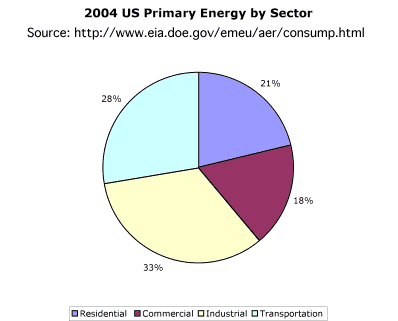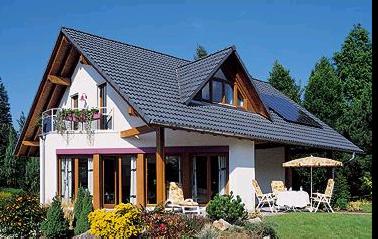A Brief Look at Three Regions
Most energy efficiency analysis is regional — here are links to discussions in three important regions. The US national government is not currently emphasizing climate change and energy issues as much as some of the individual states, so links are provided to two California documents.
The European Union
An EU report (Action Plan for Energy Efficiency: Realising the Potential) asserts that 20% of EU energy can be saved by cost-effective methods. (Note: Europeans have relatively high power and fuel prices.) In residential (retrofitted wall and roof insulation) and commercial (improved energy management systems) buildings, this potential is 27% and 30% respectively. Lower energy appliances, lighting, and equipment are important to this reduction. The potential savings in manufacturing is about 25% (motors, fans and lighting). The 26% savings in transportation requires shifting modes of transportation.
Given the importance of the human factor in reducing energy consumption, this action plan also encourages citizens to use energy in the most rational manner possible. Energy efficiency is about informed choice by individuals, not just about legislation.
Plans include:
• Better labeling of appliances for consumers and minimum energy standards
• Building performance requirements and very low energy buildings (“passive houses”).
• Improved electricity production and transmission.
• Reduced greenhouse gas emissions from cars to below 120 g CO2/km (averaging 39.2 mpg for gasoline engines and 44.4 mpg for diesel). There is a voluntary goal of 140 g CO2/km by 2008/2009. See Green Car Congress’s 2006 look at which cars are on target to meet the voluntary reductions. Additionally, better tires and tires at the correct pressure can improve vehicle fuel efficiency by more than 5%.
• Providing education and training for energy managers in industry and utilities. Provide teaching aids for elementary, secondary, and vocational ed curricula.
• Bringing together a “Covenant of Mayors†from 20 – 30 of Europe’s largest and most pioneering cities to discuss what works.
• An international framework for both the developed and developing world.

Renault is on track to meet the guidelines, having reduced average carbon emissions from 169 g/km in 1997 to 139 g/km in 2004. The Clio III gets 64 mpg, 117 g CO2/km.
United States
In 2004, Americans consumed 9,336 BTU/$2000 GDP, comparable to the northerly Swedish and 50% more than the British and Swiss. (See World Energy Intensity–Total Primary Energy Consumption per Dollar of Gross Domestic 2004). We are rich, we pay relatively little for fuels and electricity, and we use them inefficiently. We have lots of room for improvement!
Presumably Americans can also reduce energy use more than 20% in a cost effective manner, and even more if we increase the price of energy to more accurately reflect its costs.
Per person electricity consumption has remained flat in California over the last 30 years, while increasing 45% in the US. This has coincided with the nationwide introduction of air conditioners and increase in the percentage of Americans living where air conditioning is considered necessary, the larger house, and California programs to reduce electricity and natural gas use. The California Energy Commission 2005 Integrated Energy Policy Report estimates 30,000 GWh can be saved over the next decade with an aggressive energy savings goals. This represents more than 10% of today’s consumption, but with population and per capita income increases, shifts in where Californians live, electricity consumption is still expected to increase by 10% even so.
A competing priority is to reduce electricity use especially during peak usage times, when cost and pollution rise. Some peak power plants only operate a few hours/year, and reliability margins are tight in southern California. The peak load plants are least efficient, so saving a kWh there reduces GHG more than at other natural gas plants. Additionally, power companies pay every electricity producer whatever they pay the most expensive. The priority will shift from reducing lighting – with its enormous energy use – to emphasizing air conditioning and commercial lighting. The emphasis on new building construction and appliance standards has helped reduced the peak load utilities must produce by 6,000 MW, and more savings are expected.

The Climate Action Team Report to Governor Schwarzenegger and the Legislature looks at what may happen in CA if GHG emissions are not decreased, priorities, and how to achieve them.
Efficiency priorities include reducing idling in diesel engines, vehicle and tire standards, water use (19% of CA electricity goes to water!), appliances, and buildings.
China
In a recent discouraging trend, the energy use in China is now increasing faster than GDP.

For more than two decades, increases in energy were well below increases in GDP, a striking achievement for a developing economy. China accomplished this by investing in improving efficiency, 10 – 13% as much as in new energy sources, in the 1980s. This dropped to 9% in the 1990s. Energy use doubled in these two decades, while GDP quadrupled. The Chinese hope to repeat this accomplishment in the two decades 2000 – 2020.
Energy Efficiency Investment has Declined as a Proportion of Total Energy Investment

[The] continuation of a trend that became particularly pronounced after 1996. As a percent of energy supply investment, energy efficiency investment fell from a high of 13% in 1982 to a low of about 3% in 1996, with only a slight rebound since then.
Chinese academics told Deng Xiaoping early that China’s economic growth would be much slower if energy were not used much more efficiently. During his leadership, a close relationship was established with a number of foreign groups, including Lawrence Berkeley Lab’s China Energy Group in the Environmental Energy Technologies Division.
One of their publications is Evaluation of China’s Energy Strategy Options (download from here).
Many of us in the West still see China as a centrally planned economy, but it faces some of the same problems we in the US see:
China cannot meet its soaring demand for energy services without substantially increased investment in energy efficiency. Energy conservation seems like common sense, but there are entrenched interests in every country—oil companies, gas companies, coal companies—pushing to expand supply rather than cut demand.
The to-do list is formidable.
• Create a Ministry of Energy to promote environmental protection and energy efficiency. It would require much increased staffing, better data to support decision-making, and integrate consideration across sectors such as environmental degradation and regional inequality. Relatively few people administer energy policy in China compared to other major energy users.
• Financial recommendations include spending 10% of energy investment on efficiency. China would pay some of the costs herself, but could try to get foreign investment as well.
• Regulatory recommendations include better enforcement of existing standards, tighter standards for fuel economy, as well as appliances, utilities, and industry. Ensure that prices of energy reflect energy goals. Prepare long-term strategic infrastructure plans for land-use and transportation.
• Advocacy goals include continuing public outreach programs, and making efficiency agreements with industry.
This report also addresses topics unrelated to efficiency, such as subsidies for renewables and clean coal.
Summary
Reducing energy use by increasing energy efficiency is doable, and there are many paths that will save money. Lots of money. We can hope that interest in efficiency, and money for research and advocacy, moves up priority lists.























